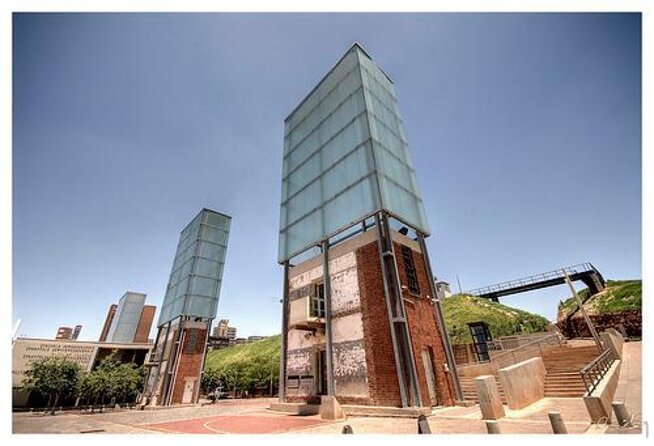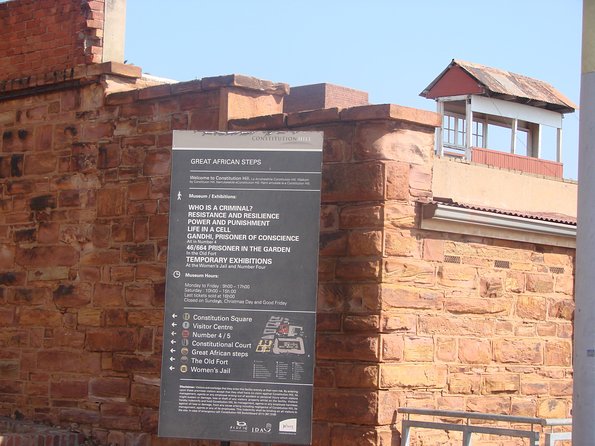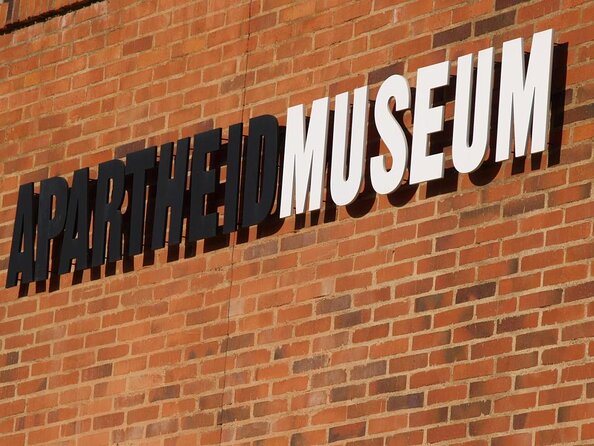Hidden within the heart of Johannesburg lies a unique combination of historical landmarks that offer a profound glimpse into South Africa’s tumultuous past.
Few may know that by exploring Constitution Hill and the Apartheid Museum together, visitors can embark on a captivating journey through the nation’s struggle for democracy.
With its former role as a prison and military precinct, Constitution Hill stands as a testament to the resilience and determination of those who fought against the oppressive apartheid regime.
Meanwhile, the Apartheid Museum takes visitors on a thought-provoking exploration of the system that enforced racial segregation and discrimination.
As the doors of these two iconic sites open, a wealth of knowledge and insights awaits, illuminating the path towards a future of equality and freedom.
Good To Know

- South Africa’s journey to democracy was marked by deep-rooted racial segregation and discrimination under apartheid.
- The end of apartheid paved the way for democracy and equality, with the drafting and adoption of a new constitution.
- Constitution Hill and the Apartheid Museum provide immersive experiences and insights into South Africa’s struggle for democracy.
- Nelson Mandela played a crucial role in the fight against apartheid and emphasized reconciliation and forgiveness in the transition to democracy.
South Africa’s Journey to Democracy

South Africa’s journey to democracy was a turbulent and transformative period in the nation’s history. The apartheid era had a profound impact on society, with deep-rooted racial segregation and discrimination. Under apartheid, the majority Black population was subjected to oppressive laws and policies that denied them basic human rights and opportunities.
The impact of apartheid on society was far-reaching, leading to social, economic, and political divisions. It created a system of separate development, where different racial groups were forced to live separately and had limited interaction with one another. This resulted in the fragmentation of communities and the perpetuation of inequality.
The journey to democracy involved a long and difficult struggle against apartheid, with activists, leaders, and ordinary citizens coming together to fight for equality and justice. It was a period of immense change and hope, culminating in the dismantling of apartheid and the birth of a new democratic South Africa.
Like museums? Other Johannesburg cultural attractions we've reviewed
Tour Itinerary and Highlights

As visitors embark on the tour of Constitution Hill and the Apartheid Museum, they will be immersed in a captivating journey that unravels the tumultuous history of South Africa’s struggle for democracy. The tour highlights the significance of Constitution Hill as a former prison and military precinct that played a pivotal role in the country’s political division. At Constitution Hill, visitors can explore interactive exhibits and gain insights into the harsh realities faced by political prisoners during apartheid. The Apartheid Museum complements this experience by providing a rundown of South Africa’s journey to democracy. Together, these two sites offer a powerful and thought-provoking exploration of the country’s past, allowing visitors to gain a deeper understanding of the challenges and triumphs that shaped modern South Africa.
| Tour Highlights | Significance of Constitution Hill |
|---|---|
| Interactive exhibits | Former prison and military precinct |
| Insights on political division | Pivotal role in the country’s history |
| Comprehensive overview of South Africa’s journey to democracy | Understanding the challenges and triumphs of the past |
History and Significance of Constitution Hill
Constitution Hill holds a rich and significant history as a former prison and military precinct that played a pivotal role in shaping South Africa’s political landscape. Its impact on society and the legacy it left behind are profound.
The history of Constitution Hill is intertwined with the story of racial segregation in South Africa. During the apartheid era, the prison complex housed political prisoners, including Nelson Mandela and Mahatma Gandhi, who fought against racial discrimination. The harsh conditions and brutal treatment endured by inmates at this site became emblematic of the struggle for freedom and equality.
Today, Constitution Hill stands as a symbol of resilience and serves as a reminder of the injustices of the past. Through its interactive exhibits and insightful displays, visitors can gain a deeper understanding of South Africa’s history and the ongoing fight for social justice.
Former Prison and Military Precinct
With its deep historical roots and captivating stories, the former prison and military precinct at Constitution Hill provides a compelling glimpse into South Africa’s tumultuous past. Here are four reasons why this part of Constitution Hill is a must-visit:
Historical Significance: The former prison and military precinct played a crucial role in South Africa’s history, serving as a site of incarceration and oppression during the apartheid era. It was here that political activists and freedom fighters, including Nelson Mandela, were unjustly held.
Interactive Exhibits: The precinct offers interactive exhibits that bring the stories of those who were imprisoned to life. Visitors can explore the cells, learn about the conditions prisoners endured, and gain a deeper understanding of the struggle for freedom.
Political Division: The former prison and military precinct sheds light on the political division that plagued South Africa during apartheid. It highlights the injustices committed and the resilience of those who fought for equality and justice.
Symbol of Transformation: Today, the former prison and military precinct stands as a powerful symbol of transformation and reconciliation. It serves as a reminder of the progress South Africa has made and the ongoing work towards a more inclusive society.
Interactive Exhibits at the Apartheid Museum
Visitors to the Apartheid Museum are immersed in a thought-provoking experience through its interactive exhibits, which vividly depict the realities of apartheid and the struggle for equality in South Africa. These exhibits bring the history of apartheid to life, allowing visitors to engage with the subject matter and gain a deeper understanding of the impact it had on the country.
One of the interactive exhibits at the museum is a replica of a prison cell, giving visitors a glimpse into the harsh conditions endured by political prisoners during the apartheid era. Another exhibit allows visitors to listen to firsthand accounts of individuals who lived through apartheid, providing a personal perspective on the history. Plus, there are interactive displays that challenge visitors to make difficult decisions faced by individuals during apartheid, highlighting the complexities of the time.
The interactive exhibits at the Apartheid Museum provide a powerful and educational experience, allowing visitors to engage with and reflect on the history of apartheid in South Africa.
| Interactive Exhibits | Apartheid History |
|---|---|
| Replica prison cell | Harsh conditions endured by prisoners |
| Firsthand accounts | Personal perspective on apartheid |
| Decision-making challenges | Complexities of the apartheid era |
Political Division and Insights
The political division during the apartheid era in South Africa left a lasting impact on the country, shaping its history and society in profound ways. Here are four key insights into this period of political conflict and racial segregation:
Systematic Oppression: Apartheid was a system of institutionalized racial segregation enforced by the government, which led to the marginalization and oppression of non-white South Africans.
Resistance and Activism: Despite the oppressive regime, many individuals and organizations fought against apartheid through protests, strikes, and acts of civil disobedience, contributing to the eventual downfall of the system.
Human Rights Violations: Apartheid was characterized by numerous human rights violations, including arbitrary arrests, torture, and forced removals. These violations were condemned by the international community and played a crucial role in the global fight against racial injustice.
Transition to Democracy: The end of apartheid marked a significant turning point in South Africa’s history. Through negotiations and the leadership of figures like Nelson Mandela, the country transitioned to a democratic society, paving the way for reconciliation and the pursuit of equality.
Understanding the political division and insights of the apartheid era is essential to fully comprehend South Africa’s journey towards freedom and equality.
Cancellation Policy and Refund Details
To ensure a smooth experience, please be aware of the cancellation policy and refund details for the Constitution Hill and Apartheid Museum tour.
If you need to cancel your booking, make sure to do so at least 24 hours before the start time to receive a full refund. Unfortunately, if you cancel less than 24 hours before the start time, no refund will be provided. It’s important to note that changes made less than 24 hours before the start time won’t be accepted. These cut-off times are based on the local time of the tour.
Before making any decisions, it’s always a good idea to check out traveler experiences and Viator reviews to get a better understanding of what to expect.
Pricing and Booking Information
When planning your visit to Constitution Hill and the Apartheid Museum, you’ll find all the pricing and booking information you need to ensure a seamless experience. Here are four key details to consider:
Pricing Comparison:
The combined ticket for Constitution Hill and the Apartheid Museum is priced at $101.98. This includes access to both attractions and provides excellent value for those interested in South Africa’s journey to democracy.Recommended Tour Duration:
To fully appreciate the historical significance and interactive exhibits, it’s recommended to allocate at least a full day for your visit. This will allow you to explore both sites at a leisurely pace and learn about the rich history of apartheid and the struggle for freedom.Booking Process:
To secure your visit, it’s advisable to book your tickets in advance. This can be done through the official website of Constitution Hill and the Apartheid Museum or through authorized tour operators. Online booking ensures availability and saves you time on the day of your visit.Additional Costs:
Keep in mind that there may be additional costs for guided tours, audio guides, or special exhibitions. It’s worth checking the official websites for any special promotions or discounts that may be available.
Common Questions
Can I Take Photographs Inside the Apartheid Museum?
Yes, visitors are allowed to take photographs inside the Apartheid Museum. However, there are some restrictions and regulations that must be followed. Please check the museum’s photography policy for more information.
Are There Any Age Restrictions for Visiting Constitution Hill and the Apartheid Museum?
There are no age restrictions for visiting Constitution Hill and the Apartheid Museum. However, it’s important to note that photography is not allowed inside the museum. Visitors of all ages can explore the rich history and significance of these sites.
Is Transportation Included in the Tour Price?
Yes, transportation is included in the tour price. Visitors can enjoy the convenience of having transportation provided for them, ensuring a hassle-free experience exploring Constitution Hill and the Apartheid Museum.
Are There Any Discounts Available for Students or Seniors?
Yes, there are student and senior discounts available for the tour. Students and seniors can enjoy discounted prices on their tickets, making it more affordable for them to visit Constitution Hill and the Apartheid Museum.
Is There a Café or Restaurant on Site at Constitution Hill or the Apartheid Museum?
Yes, there is a café and restaurant available at both Constitution Hill and the Apartheid Museum. Visitors can enjoy a meal or grab a snack while exploring the exhibits. As for the photography policy, it is best to inquire directly with the staff on site.
The Sum Up
To sum it up, a visit to Constitution Hill and the Apartheid Museum offers a captivating journey through South Africa’s past and provides valuable insights into the nation’s transformation towards democracy.
These iconic sites shed light on the struggles and sacrifices made during the apartheid era, offering visitors a deep understanding of the country’s history.
By exploring the former prison, engaging with interactive exhibits, and delving into the history and impact of apartheid, visitors can gain a comprehensive understanding of South Africa’s journey to equality and freedom.
More Museum Tours in Johannesburg
More Tour Reviews in Johannesburg
Looking for something different? Other Johannesburg activities we've written about
- Soweto guided tour (Half-day)
- Soweto: Cycling Excursion with lunch
- Soweto Tour; Mandela House; Vilakazi Street; Market Culture
- Soweto & Nelson Mandela House Visit
- Soweto Township Tour
- Soweto: Bike Tour with a Local Tour Guide
- Soweto and apartheid museum tour(Half-day)
- Johannesburg: Pretoria, Apartheid & Soweto Small-Group Tour
- Pilanesberg Game reserve safari with pickup in Johannesburg
- Pilanesberg Game Reserve Full Day Safari
- Soweto Street Food & Beer Walk
- OR Tambo Airport Private Transfer To Sandton
